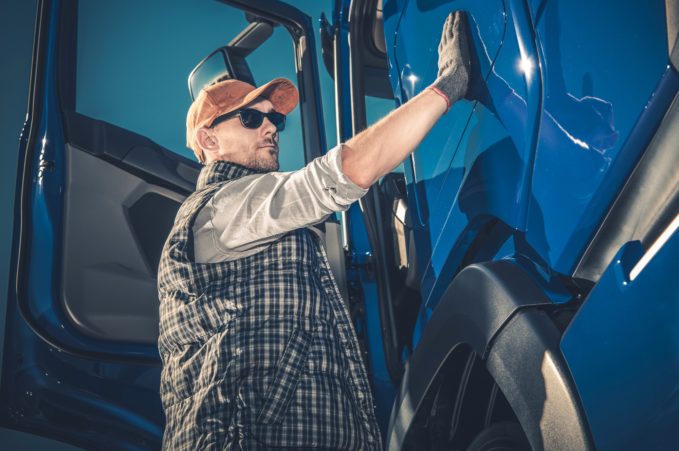
By Ed Pierce, Contributing Editor
February 4, 2022
Cargo theft has plagued truck drivers and businesses in the supply chain for years now. In order to help fleet managers identify vulnerabilities and better prevent cargo theft, Fleet Management Weekly interviewed Scott Cornell of Travelers Insurance.
As the National Transportation Practice Leader for Travelers Insurance, Scott has the kind of insight necessary to help fleet managers perform the right preventive measures to reduce the risk of cargo theft.
1. Can you set the stage for our readers by giving us some background on Travelers and your role with the company? What types of clients do you serve?
Travelers specializes in cargo insurance for all aspects of the supply chain. Everything from trucking to intermediaries to freight brokers is covered by Travelers cargo insurance. My role is to lead the transportation effort within the company. I began working at Travelers in 2002 and helped create the Special Investigations Group (SIG) in 2005. SIG investigates cargo theft, and its objective is to prevent cargo theft and recover stolen cargo for our clients.
2. Please share some trend information regarding cargo theft to set the stage for fleet managers. Pre-COVID? COVID? 2021 and today?
Major impactful events to the economy play a large role in cargo theft trends. Prior to the economic downturn in 2008, a lot of money was spent on luxury items such as electronics, televisions, and tablets. The economic downturn happened in 2008 and by 2010 food & beverage became the top targeted commodity by thieves as people became more focused on basic needs.
Food and beverage cargo was particularly attractive for criminals to target because of the disposable nature of these products. Perishable goods are also less easily traced, and even if they are recovered, there’s little chance for them to be reintroduced into the supply chain.
Food and beverage retained the number one spot until the COVID pandemic in 2020. That was the year home goods took over as the top targeted commodity as more and more people were working from home and spending increased amounts of time at home. Home supplies were selling at an all-time high as people needed supplies to build home offices and to replace workplace supplies.
Of course, trends can change based on region. For example, weather events such as hurricanes can cause cargo thieves to target building supplies such as lumber or roofing materials due to the sudden increased demand. As for what’s currently trending in the tail end of 2021, electronics seems to be regaining its top spot, especially in California.
3. Tell us about the trends you are seeing in cargo theft and the cost of those stolen goods?
The good news is that the average value per load has steadily decreased. The average value per load was $175,000 in 2019 and went down to $162,000 in 2020. It continued to fall in the first half of 2021.
However, a recent increase in pilferage theft – cargo thieves stealing partial loads instead of an entire truckload — played a large part in this trend. By taking a few pallets or boxes rather than the entire truckload lowered the average value per load.
4. What types of theft are you seeing?
Cargo theft is generally committed by organized cargo theft groups. These groups are familiar with the supply chain and perform surveillance on distribution centers and drivers in order to exploit their weak spots. These criminals would often monitor the drivers and wait for a moment in which a driver took an extended break for a meal or a shower to commit theft.
Investigators identify two distinct categories of theft: straight theft and strategic theft. Straight theft is when cargo thieves physically go out and steal cargo from where it’s sitting. This could be in truck stops, parking lots, industrial centers, warehouse drop lots, or trucking companies. In straight theft, thieves will physically take either the whole tractor and trailer or just partial loads.
Strategic theft works a little bit differently. With strategic theft, cargo thieves trick someone in the intermediary part of the supply chain into giving them the cargo. They usually use tactics such as identity theft, fictitious pickup, and double-brokering scams to steal from either the freight brokers or the 3PLS. (third party logistics).
The way the identity theft tactics usually work is that once a load gets posted or advertised looking for a trucking company to move it, organized rings of cargo thieves will steal the identity of a legitimate trucking company and pose as them in order to get booked on the load. Then, once they’ve picked up the load, they disappear, leading the freight brokers or 3PLS to discover the deception once they call the trucking company.
With a fictitious pickup, cargo thieves will insert themselves at the point of pickup. This means that if they learn that a load will be picked up at 1 pm on a Friday, then they’ll arrive at 11 am that same day at the point of pickup posing as the trucking company. Then, once the actual trucking company shows up a couple of hours later, the thieves are long gone. This sort of strategic theft has been very prevalent since it first came on the scene around 2012.
5. What are the vulnerabilities that lead to theft?
Potential vulnerabilities such as a disrupted supply chain play a large part in the prevalence of cargo theft. When cargo is left sitting around, they’re much more vulnerable to theft. Luckily, in addition to investigating cargo theft, our team works with clients to teach them prevention methods. This supports our mission of prevention through a three-layered approach to dealing with cargo theft.
The first layer of the approach is to have a foundation of good processes and procedures, namely in educating the drivers on cargo theft. By educating drivers about the current types of theft going on today and what’s being stolen, they become much more likely to avoid the weaknesses that thieves are currently exploiting.
Giving drivers an active role in theft prevention by arming them with information pertinent to their specific cargo is imperative. For example, if they’re hauling electronics in Southern California, they should be taught how electronics are currently being stolen and where it’s most likely to happen.
 We believe that drivers should be shown different techniques for locking their trailers, how to use different locking devices, and the importance of parking in well-lit and secure areas. Because so many thieves wait for a driver to stop to get fuel or food, drivers must be trained to perform all the necessary tasks prior to picking up the load.
We believe that drivers should be shown different techniques for locking their trailers, how to use different locking devices, and the importance of parking in well-lit and secure areas. Because so many thieves wait for a driver to stop to get fuel or food, drivers must be trained to perform all the necessary tasks prior to picking up the load.
By making the act of picking up the load the final task before hitting the road, drivers decrease the chances of cargo thieves following them for 150-200 miles until their next stop. This prevention process is known as the red zone process for drivers, and most cargo thieves will not target drivers who follow it.
The second layer is the use or introduction of hard-locking devices. Because pilferage is so rampant, where thieves reach the rear doors and swipe a pallet or a few boxes, a high-quality, high-security rear door lock will make this a much harder target. It’s the same theory as the red zone process, as thieves aren’t looking for difficult targets to rob.
By making trucks as hard a target as possible, drivers can prevent theft. If drivers must park the trailer without it being married to the tractor, landing gear locks are an excellent option. If the tractor and trailer are parked together, drivers should be using air cuff locks
The third layer is the use of covert tracking. By planting tracking devices inside the cargo or the trailer, then it makes it that much easier to track down the load once it’s been stolen. Because thieves usually switch their own tractor in on the trailer within a few miles of the theft, it’s less effective to plant tracking devices in the tractor rather than in the trailer. But the ideal tracker device location is to plant it in the cargo – the real objective of the thieves.
6. Is there a seasonal aspect of cargo theft?
As the holidays approach and distribution centers begin filling up just before the fourth quarter, this increases the amount of cargo available for theft. Cargo thieves are more active around the holidays as organized rings of thieves target the hottest commodities that have come out. This includes commodities such as new game releases, game consoles, technology, tablets, and phones.
Another seasonal impact on cargo theft is the theft of food and beverages. Because there’s a harvest season for certain food stuffs such as fruits, nuts and vegetables, thievery is going to increase around harvest seasons.
7. How do businesses reduce the risk of cargo theft? Vendors, partners, drivers, employees?
One excellent way to keep track of theft trends throughout the year is through CargoNet. CargoNet is a service that aggregates voluntarily-reported cargo theft incidents across the country and identifies certain trends amongst the data.
Cargo theft data gets reported to them through clients, regional transportation security councils, and even law enforcement. CargoNet analyzes the data and reports trends that can help vendors and drivers know what is most likely to get stolen.
Because the data is voluntarily reported, it is not 100% accurate, but provides a good sampling of the total numbers of cargo. It’s one of the industry’s most reliable indicators of trends and that can serve as a bellwether for those involved with cargo theft prevention.
8. How does Travelers work with its clients to prevent theft and reduce risk?
Travelers started our cargo theft investigation team in 2005, and we respond 24/7, 365 days a year to cargo theft on behalf of our clients. The team has grown to ten investigators located in the major hotspots for cargo theft such as California, Texas, Florida, New Jersey, and Chicago. We have recovered millions of dollars in stolen goods for their clients.
In addition to responding to acts of cargo theft, the team has a risk mitigation partnership with clients to reduce risk and loss by working with them on a preventive basis. In addition to the millions of dollars of stolen goods recovered for clients, we’ve prevented countless more millions in cargo theft through education and preventive measures.
We collaborate with clients to determine what kind of commodities they’re hauling and whether or not they match current cargo theft trends. Our team walks clients through just how the commodities are being targeted, how the trucks are being hit, and whether they’re being pilfered or stolen in hold. They will then teach them good preventive methods to avoid theft including good, hard locking devices or covert tracking.
This comprehensive approach is highly sought out by our clients, who appreciate our team’s expertise and ability to mitigate risk.





